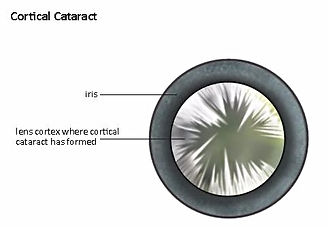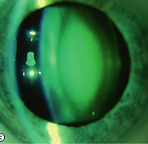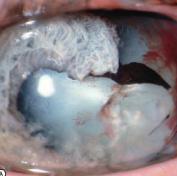

CATARACT
An opacification in the crystalline lens
-
Symptoms:
-
Visual acuity loss
-
Reduced contrast sensitivity
-
Glare
-
Night driving problems
-
Due to absorption and scatter of light
-
-
Age-related cataracts:
-
NUCLEAR
-
CORTICAL
-
POSTERIOR SUBCAPSULAR
-
Can occur individually or in combination
-
When the cataract disturbs the vision i.e. lens opacifies, then removal is considered.
-
-
As the α-crystallin chaperone function decreases, there is an increase in aggregates
-
These aggregates are of a:
-
High molecular weight
-
High concentration of water-insoluble proteins
-
-
-
Light scattering and loss of transparency also increases
-
With time, the lens hardens as new layers of fibres are added
-
This causes lens yellowing, which is characteristic of a nuclear sclerosis cataract
-
-
New fibres to the cortex can cause lower layers to develop spoke-like opacities
-
Common in patients with cortical cataracts
-
-
Posterior subcapsular with a disc-like appearance, occur less commonly
-
UV exposure can increase the likelihood of cataract
-
In particular, UVB which causes cortical cataract
-
-
Congenital cataracts: where there is a genetic linkage due to an autosomal mutation
-
Other risk factors of cataract formation:
-
Trauma
-
Diabetes mellitus
-
Smoking
-
Drugs - systemic and ocular
-
-
Cataracts differ in:
-
Shape
-
Colour
-
Optical density
-
Location
-
Size
-







